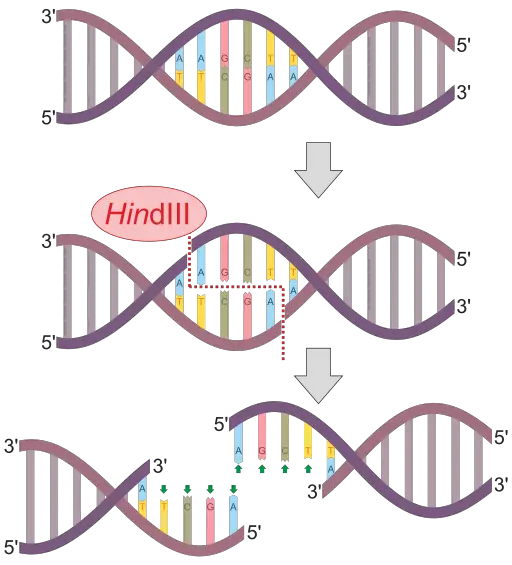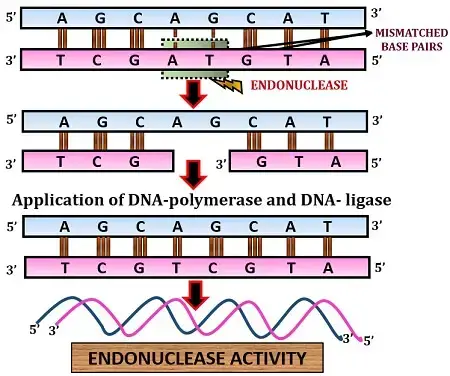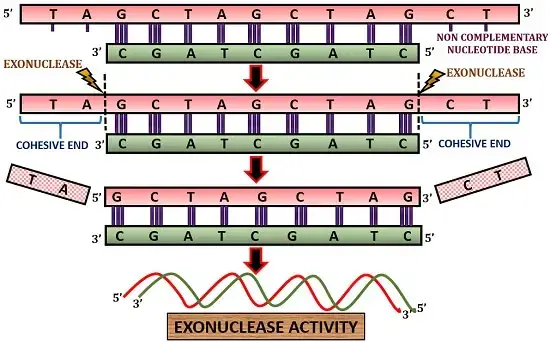Definition of Endonuclease
- An endonuclease is a group of enzymes that specifically cleave the phosphodiester bond within a polynucleotide chain. Unlike exonucleases that cleave from the ends of the chain, endonucleases have the ability to break the bond from the middle of the chain. These enzymes can target specific sequences or be non-specific in their cleavage activity.
- One notable type of endonuclease is the restriction endonuclease, which is obtained from various bacteria and archaea. Each restriction endonuclease is specific to particular sites in the polynucleotide chain. When the enzyme cleaves the DNA, it generates single-stranded ends, also known as sticky ends. These sticky ends can then be joined together using DNA ligase, resulting in recombinant DNA. This process, called recombination, has significant applications in genetic engineering and molecular biology.
- Restriction endonucleases are classified into three types based on their mechanism of action. Type I endonucleases are large multi-subunit complexes that cleave at random sites within approximately 1000 base pairs. Type II endonucleases are smaller subunits that cleave sequences without requiring ATP. Type III endonucleases are also complex enzymes that cleave sequences of around 25 base pairs.
- Endonucleases are capable of cleaving double-stranded DNA, single-stranded DNA, and even RNAs. They play a crucial role in DNA repair processes by precisely recognizing and cleaving damaged DNA. This prevents further damage and ensures accurate repair. Some endonucleases also have defensive properties, protecting cells from the entry of certain pathogens.
- While some restriction endonucleases may exhibit a lag period before their activity, which is attributed to the time required for recognition of specific sites, their cleavage ultimately results in the production of oligonucleotides. Overall, endonucleases are essential enzymes involved in DNA manipulation, repair, and defense mechanisms.

Mechanism of Endonuclease
The mechanism of endonuclease involves the cleavage of the phosphodiester bond within the polynucleotide chain. Here is an overview of the mechanism:

- Breakage of Phosphodiester Bond: Endonuclease recognizes and targets the site where there is a mismatched or incorrect nucleotide base pair within the polynucleotide chain. It cleaves the phosphodiester bond present between the mismatched nucleotides.
- Separation of Mismatched Base Pairs: Once the phosphodiester bond is broken, the endonuclease further separates the mismatched base pairs, creating a gap in the DNA molecule.
- DNA Hybrid Formation: Following the cleavage and separation of the mismatched base pairs, the DNA polymerase and DNA ligase come into play. DNA polymerase synthesizes new DNA strands by adding complementary nucleotides to the exposed DNA ends. DNA ligase then binds the newly synthesized DNA fragment with the existing DNA strand, forming a DNA hybrid or a complete DNA molecule.
- Nick Formation: Finally, the endonuclease creates a nick or a small gap in the newly formed DNA hybrid. This nick allows for further processing of the DNA molecule, such as DNA repair or DNA recombination.
The mechanism of endonuclease activity plays a crucial role in DNA repair processes, as it specifically targets and removes mismatched or damaged nucleotides within the DNA molecule. By breaking the phosphodiester bond and separating the mismatched base pairs, endonuclease creates the opportunity for DNA polymerase and DNA ligase to repair and restore the integrity of the DNA molecule.
Definition of Exonuclease
- Exonucleases are a class of enzymes that cleave DNA sequences in a polynucleotide chain from either the 5′ or 3′ end, one nucleotide at a time. These enzymes hydrolyze the phosphodiester bond between nucleotides, breaking down the chain.
- In various organisms, one of the major pathways for RNA degradation involves a complex called the exosome, which consists of multiple exoribonucleases. These exonucleases play a crucial role in degrading RNA molecules and maintaining RNA homeostasis.
- Additionally, exonucleases can be found in the venoms of snakes and lizards. These toxins function by cleaving the DNA that encodes essential proteins within the target organism’s body, leading to detrimental effects.
- During DNA replication, exonucleases play important roles. They work alongside RNA polymerase II to degrade the RNA primers that are synthesized during the initiation of DNA replication. This allows for the removal of RNA primers and their replacement with DNA nucleotides, ensuring accurate DNA replication.
- Exonuclease activity is also involved in the editing and proofreading of DNA. These enzymes help detect and remove errors or mismatches in the DNA sequence, contributing to DNA repair mechanisms and maintaining genomic stability.
- There are different types of exonucleases found in both prokaryotes and eukaryotes. These include the decapping 5′ to 3′ exonuclease (Xrn1), an independent 5′ to 3′ exonuclease, and a polyA-specific 3′ to 5′ exonuclease. Each of these exonucleases plays specific roles in RNA processing, replication, and transcription.
- Unlike endonucleases, exonucleases do not exhibit a lag period before their activity. They cleave DNA sequences from the ends, resulting in sticky ends. Instead of producing oligonucleotides, exonucleases cleave individual nucleosides from either end of the DNA chain.
- Unlike certain endonucleases, exonucleases do not possess defensive properties against the entry of pathogenic microorganisms. Their primary functions are focused on DNA and RNA processing, replication, transcription, and proofreading.
- In summary, exonucleases are enzymes that cleave DNA sequences from either end of the polynucleotide chain. They have diverse roles in DNA and RNA metabolism, including RNA degradation, DNA replication, editing, and proofreading. Exonucleases do not exhibit a lag period and cleave individual nucleosides, but they lack defensive properties against pathogenic microbes.
Mechanism of Exonuclease
The mechanism of exonuclease involves the stepwise removal of nucleotides from the polynucleotide chain, starting from either the 5′ end or the 3′ end. Here is an overview of the mechanism:

- Phosphodiester Bond Cleavage: Exonuclease initiates its action by cleaving the phosphodiester bond between the nucleotides at one end of the polynucleotide chain.
- Stepwise Nucleotide Removal: After cleaving the bond, the exonuclease removes the nucleotide from the chain, one at a time. It continues this process iteratively, sequentially cleaving and releasing nucleotides from the chain.
- Formation of Cohesive or Sticky Ends: As the exonuclease progresses along the chain, it may encounter regions where the nucleotides at the ends of the chain are not fully complementary. These overhanging ends, also known as cohesive or sticky ends, can be complementary to another nucleic acid strand.
- Hybridization and DNA Segment Formation: Once the exonuclease removes the cohesive ends, the remaining portions of the DNA strands can hybridize or anneal together. The complementary sticky ends of two DNA strands can base pair with each other, resulting in the formation of a complete DNA hybrid or a segment.
The mechanism of exonuclease activity allows for the precise removal of nucleotides from the polynucleotide chain and the subsequent joining of DNA segments through complementary base pairing. This process plays a crucial role in various biological processes, including DNA repair, replication, proofreading, and the generation of cohesive ends that facilitate the construction of recombinant DNA molecules.
Key Differences (Endonuclease vs Exonuclease)
Comparison between Endonuclease and Exonuclease:
| Basis for Comparison | Endonuclease | Exonuclease |
|---|---|---|
| Definition | An endonuclease is a group of enzymes that cleave the phosphodiester bond present within a polynucleotide chain. | Exonucleases are enzymes that cleave DNA sequences in a polynucleotide chain from either the 5’ or 3’ end one at a time. |
| Cleavage | Endonucleases cleave the nucleotide sequence from the middle. | Exonucleases cleave a nucleotide sequence from the ends. |
| Lag period | Some endonucleases like restriction endonucleases have a lag period before their activity. | Exonuclease does not have a lag period before their activity. |
| Results in | Endonucleases cleave DNA sequences, resulting in oligonucleotides. | Exonucleases cleave DNA sequences, resulting in individual nucleotides or nucleosides. |
| Ends | Endonucleases might form either sticky or blunt ends. | Exonucleases form sticky ends. |
| Specificity | Specific endonucleases, also called restriction endonucleases, are available that cleave specific sites within a DNA sequence. | Exonuclease is usually non-specific. |
| Defensive properties | Endonucleases have defensive properties against the entry of pathogenic microorganisms. | Exonucleases do not have defensive properties. |
| Effect on circular DNA | Restriction endonuclease can cleave specific sites within a circular DNA. | Exonucleases have less activity towards circular DNA as compared to linear DNA. |
| Inhibition | Endonucleases cannot be inhibited phosphorothioate bonds unless the entire sequence has the bonds between all nucleotides. | Exonuclease can be inhibited by adding five phosphorothioate bonds in a row to a sequence. |
| Free ends | Free 3’ or 5’ ends are not necessary for the action of endonucleases. | The ends should be free for the action of exonucleases. |
| Examples | EcoRI, BamHI, Deoxyribonuclease I are some examples of endonucleases. | Snake venom, Exonuclease I, Xrn1 are some examples of exonucleases. |
| Organism | It is found only in prokaryotes. | It is found in both eukaryotes and prokaryotes. |
| Product obtained | The product obtained after cleavage is oligonucleotide chains. | The product obtained after exonuclease activity is monomers of nucleotides. |
| Specificity | It cuts DNA at specific recognition sites. | It cuts DNA at random sites. |
| Ends formed | A restriction endonuclease activity either yields blunt ends or sticky ends. | Exonuclease activity always forms sticky ends. |
| Types | Type I, II, III, IV and V | 5’ to 3’ exonuclease, 3’ to 5’ exonuclease and poly (A) specific 3’ to 5’ exonuclease. |
| Lag Period | It shows a lag period during their activity. | It does not show any lag period. |
| Pathogen blocking | It plays a role in blocking cells from pathogens. | It does not have any role in blocking pathogens. |
| Mode of action | It separates the nucleotides into two or more fragments. | It removes the nucleotides one by one from the fragment. |
| Site of occurrence | Cleavage occurs in the middle of the polynucleotide chain. | Cleavage occurs at the end of the polynucleotide chain. |
| 3’ or 5’-OH groups | Does not require. | It requires. |
| Role | Plays an important role in DNA repair and also blocks the entry of pathogens. | Plays an important role in DNA repair, stabilization, and proofreading but does not block the entry of pathogens. |
Similarities Between Endonuclease and Exonuclease
Endonucleases and exonucleases share several similarities in their characteristics and functions:
- Cleavage of Nucleic Acids: Both endonucleases and exonucleases are enzymes that cleave nucleic acids. However, they differ in the specific sites where they cleave the nucleic acid chain.
- Action on DNA and RNA: Both types of nucleases can act on both DNA and RNA molecules. They can recognize and cleave phosphodiester bonds in DNA or RNA sequences.
- Involvement in DNA Repair: Endonucleases and exonucleases play important roles in DNA repair processes within the cell. They contribute to the recognition and removal of damaged or incorrect nucleotides, ensuring the integrity and stability of the genetic material.
- Hydrolytic Enzymes: Both endonucleases and exonucleases function as hydrolytic enzymes. They catalyze the hydrolysis of the phosphodiester bonds that connect nucleotides in the nucleic acid chain, resulting in their cleavage.
Despite these similarities, there are distinct differences between endonucleases and exonucleases. Endonucleases cleave nucleic acids within the polynucleotide chain, while exonucleases cleave the nucleic acid chain from either the 5′ or 3′ end. Endonucleases may produce oligonucleotide fragments, while exonucleases release nucleotides one at a time. Additionally, their mechanisms of action, specificities, and involvement in different cellular processes may vary.
However, the shared characteristics of acting on both DNA and RNA and participating in DNA repair highlight the important roles that both endonucleases and exonucleases play in maintaining the integrity and functionality of genetic material within the cell.
Examples of endonucleases
There are several examples of endonucleases, including:
- EcoRI: EcoRI is a commonly used restriction endonuclease obtained from the bacterium Escherichia coli. It recognizes and cleaves DNA sequences containing the specific recognition site GAATTC.
- BamHI: BamHI is another restriction endonuclease derived from Bacillus amyloliquefaciens. It recognizes and cleaves DNA sequences containing the specific recognition site GGATCC.
- HindIII: HindIII is a restriction endonuclease isolated from Haemophilus influenzae. It cleaves DNA sequences containing the specific recognition site AAGCTT.
- Deoxyribonuclease I (DNase I): DNase I is an endonuclease found in various organisms, including humans. It cleaves DNA at random sites, leading to the degradation of DNA molecules.
- Type II restriction endonucleases: There are numerous type II restriction endonucleases obtained from various bacteria. Examples include SmaI, XbaI, XhoI, and many more. Each type II endonuclease recognizes a specific DNA sequence and cleaves it at a defined position.
Examples of exonucleases
There are several examples of exonucleases, including:
- Exonuclease I: Exonuclease I is an enzyme that cleaves DNA or RNA sequences from the 3′ end, one nucleotide at a time. It is commonly used in molecular biology research for applications such as DNA sequencing and removal of unwanted nucleotides.
- Xrn1: Xrn1 is a 5′ to 3′ exonuclease found in both prokaryotes and eukaryotes. It is involved in RNA degradation and plays a role in mRNA turnover and quality control.
- Poly(A)-specific ribonuclease (PARN): PARN is an exonuclease that specifically targets the poly(A) tails of mRNA molecules. It degrades the poly(A) tails, leading to mRNA decay and regulation of gene expression.
- RNase H: RNase H is an exonuclease that cleaves the RNA strand of an RNA-DNA hybrid molecule. It plays a role in DNA replication, repair, and processing of RNA-DNA hybrids.
- Snake venom exonucleases: Some snake venoms contain exonucleases that cleave DNA or RNA sequences. These enzymes are often used for research purposes and have applications in molecular biology techniques.
Key Difference Between Endonuclease and Exonuclease – Endonuclease vsExonuclease
The key differences between endonuclease and exonuclease can be summarized as follows:
- Definition: Endonuclease cleaves the polynucleotide chain, separating nucleotides other than the two end ones. Exonuclease cleaves the polynucleotide chain from the end by removing nucleotides one by one.
- Mechanism of Action: Endonuclease cleaves nucleic acids at the middle of the nucleic acid chain, while exonuclease cleaves nucleic acids at the ends of the chain.
- Lag Phase: Endonuclease, specifically restriction endonucleases, undergoes a lag period before their activity. Exonuclease does not have a lag period before their activity.
- Results: Endonuclease cleavage results in oligonucleotides, whereas exonuclease cleavage results in single nucleotides or nucleosides.
- Blunt/Sticky Ends: Endonuclease may produce either blunt ends or sticky ends after cleavage. Exonuclease, on the other hand, forms sticky ends.
- Role: Endonucleases have a role in blocking the entry of pathogens, whereas exonucleases do not have a significant role in blocking pathogen entry.
- Examples: Examples of endonucleases include DNases, S1 nuclease, and various restriction enzymes such as Bam H1, Hind III, and Eco RI. Examples of exonucleases include snake venom, spleen phosphodiesterase, the 3′ to 5′ exonuclease domain of DNA polymerase III, and the 5′ to 3′ exonuclease activity and 3′ to 5′ exonuclease domain of DNA polymerase I.
These differences highlight the distinct mechanisms, functions, and properties of endonucleases and exonucleases, demonstrating their unique roles in nucleic acid processing and cellular functions.
FAQ
What is the main difference between endonuclease and exonuclease?
The main difference is in their cleavage locations. Endonucleases cleave within the polynucleotide chain, while exonucleases cleave from the ends of the chain.
Do endonucleases and exonucleases cleave DNA or RNA?
Both endonucleases and exonucleases can cleave both DNA and RNA molecules.
How do endonucleases and exonucleases differ in their mechanisms of action?
Endonucleases break the phosphodiester bond within the polynucleotide chain, whereas exonucleases remove nucleotides one by one from the ends of the chain.
Can you provide examples of endonucleases and exonucleases?
Examples of endonucleases include restriction enzymes like EcoRI, BamHI, and HindIII. Examples of exonucleases include snake venom exonuclease, spleen phosphodiesterase, and DNA polymerase I exonuclease domain.
What types of ends are formed after cleavage by endonucleases and exonucleases?
Endonucleases can produce either blunt ends or sticky ends, while exonucleases typically result in sticky ends.
Are endonucleases and exonucleases specific in their cleavage sites?
Endonucleases can be specific or non-specific, with specific endonucleases, known as restriction enzymes, cleaving at specific recognition sites. Exonucleases are generally non-specific.
Do endonucleases and exonucleases have any defensive properties?
Endonucleases, particularly restriction endonucleases, can have defensive properties against the entry of pathogenic microorganisms. Exonucleases do not possess such defensive properties.
What are the implications of endonuclease and exonuclease activities in DNA repair?
Both endonucleases and exonucleases play important roles in DNA repair processes by recognizing and cleaving damaged or mismatched DNA sequences. They contribute to the removal of damaged segments and subsequent DNA synthesis and repair.
Are endonucleases or exonucleases more commonly found in prokaryotes or eukaryotes?
Endonucleases are more commonly found in prokaryotes, while exonucleases are found in both prokaryotes and eukaryotes.
How do endonucleases and exonucleases contribute to genetic engineering and recombinant DNA technology?
Endonucleases are crucial in genetic engineering as they can recognize and cleave specific DNA sequences, enabling the insertion or removal of specific genetic material. Exonucleases play a role in proofreading and editing DNA during genetic engineering processes.
Reference:
- McMahon, Mary, and O. Wallace. “What is an Endonuclease?” WiseGEEK. Conjecture Corporation, 04 July 2017. Web. Available here. 01/06/2023.
- Lodish, Harvey. “The DNA Replication Machinery.” Molecular Cell Biology. 4th edition.U.S. National Library of Medicine, 01 Jan. 1970. Web. Available here. 01/06/2023.
- “Exonuclease.” Wikipedia. Wikimedia Foundation, 01 Aug. 2017. Web. Available here. 01/06/2023.
- Text Highlighting: Select any text in the post content to highlight it
- Text Annotation: Select text and add comments with annotations
- Comment Management: Edit or delete your own comments
- Highlight Management: Remove your own highlights
How to use: Simply select any text in the post content above, and you'll see annotation options. Login here or create an account to get started.